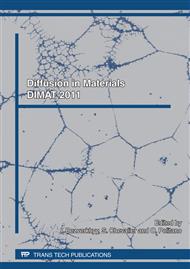p.81
p.89
p.95
p.101
p.109
p.115
p.121
p.127
p.133
Simulation of Metal/Oxide Interface Mobility: Effects of Mechanical Stresses on Geometrical Singularities
Abstract:
During the last decade, an increasing importance has been given to the feedback of mechanical stresses on the chemical diffusion and, further, on corrosion. Many works point the active role of stresses on the material ageing especially on their negative consequences leading to the damaging of structures. Based on a theoretical study and using numerical tools and experimental results our previous works [1, on stress/diffusion coupling, highlight the strong influence of stress field on the diffusion process. The aim of the present paper is to describe the influence of some particular morphologies of the metal/oxide interface on both diffusion and oxidation process. The oxidation is assumed to be driven by a mass conservation law (Stefan's law) while the diffusion coefficient of oxygen in metal is locally influenced by the stress field. The stability of a waved-shape interface is studied in both cases: simple diffusion and coupled stress/diffusion process. In this purpose we have developed an original numerical model using a virtual metal/oxide interface of a mono-material with oxygen concentration-dependent parameters, which allows to operate easily with any shape of interface and to use simple finite element meshes. Furthermore, in order to underline in a more obvious way the consequences of mechanical stress on the diffusion process, a particular geometry is studied.
Info:
Periodical:
Pages:
109-114
Citation:
Online since:
April 2012
Authors:
Price:
Сopyright:
© 2012 Trans Tech Publications Ltd. All Rights Reserved
Share:
Citation:


